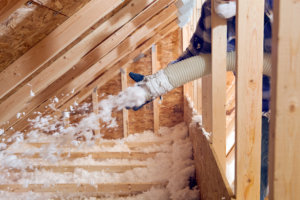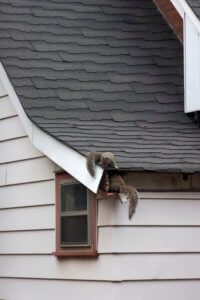Having the right amount of insulation in your attic is crucial for saving energy on heating and cooling your home. And a considerable spike in your energy bill is a big giveaway that your insulation needs updating. While insulation is a purchase that isn’t necessarily a “fun” home project, it can help lower your energy bills (putting money in your pocket!). When your home begins to feel excessively hot or cold, the attic should always be the first place you add or replace insulation.
One of the most valuable improvements you can make in your home is proper attic insulation, which gives you a 107.7% return.*
How much attic insulation do I need?

All too often, air is entering and exiting attics without homeowners even knowing. And as a result, money is rapidly leaving bank accounts. Determining the right amount of attic insulation depends on several factors including:
- Number of walls
- Length and width of walls
- Number of windows
- Length and width of windows
- Number of doors
- Length and width of doors
- The climate zone your home is located in
Do old homes have insulation issues?
In short, maybe. Owning an older home or a brownstone can sometimes lead to unexpected issues, as many tend to be historical. Older homes are more likely to have older insulation, or possibly, no insulation at all — they could just have open cavities in the walls and attic. The first step is to have an inspection completed to help you better understand what’s going on in your attic.
What are the different kinds of insulation, and how long do they last?
When insulating your home, you can choose from many types of insulation. The three most common types of insulation materials are fiberglass, cellulose, and foam. After selecting the type of insulation you need, you’ll need to pick what form works best for your home – loose-fill, batts, rolls, foam board, spray foam, and radiant barriers.
- Fiberglass insulation is a popular choice because it is both practical and cost-effective. Unless damaged, fiberglass insulation can last 80 to 100 years in most houses before it needs to be replaced.
- Blown-in cellulose insulation can last anywhere from 20 to 30 years because it’s primarily made from recycled materials that will degrade over time.
- When properly applied, foam insulation can last the lifetime of your home because it adheres exceptionally well to virtually all substrates and maintains its integrity for years to come.
What are the negatives to not replacing insulation?
Your attic provides a barrier between your home and the outside elements. When insulation declines, several things can go wrong including:
- Wasting energy can become a costly mistake as you’ll find yourself cranking up the heat or air conditioning to stay comfortable.
- Homes with insufficient insulation can experience moisture accumulation in their attics. That can lead to roof damage, mold, and mildew.
- If you’re thinking of selling your home, lack of insulation can become a red flag and a potential deal-breaker for buyers.
How do I prepare my attic for an insulation service?
Once you’ve decided to replace your attic’s insulation, you’ll want to prep the area so the installation goes smoothly. To do so, clear a path from the attic to the outside so the professionals can easily remove what currently exists. Next, you’ll want to clean out the attic space – if that’s not an option, push any remaining items away from the walls.
How does attic insulation affect my pest control?

Not only can new insulation help save money, but it can also help control pests. Mice, rats, cockroaches, and flies only need small openings to enter your house. And old insulation is the perfect nesting material for these pests to make themselves right at home.
Contaminated insulation can create a health risk. As pests enter your home, they can leave urine and droppings, which could discharge biological hazards into the air or drop into living spaces when attic hatches are opened.
The better insulated a home is, the more efficiently it can be heated and cooled, which means lower energy bills for you. The Western ThermoZone® Attic Insulation Program not only controls several household pests, including ants, centipedes, cockroaches, crickets, millipedes, silverfish, stink bugs, and termites, it’s also an environmentally responsible, cellulose spray-foam solution to help keep your home’s energy bills under control.